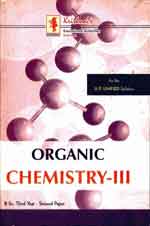|
बी एस-सी - एम एस-सी >> आर्गैनिक केमिस्ट्री-III (बी.एस-सी.-III, द्वितीय प्रश्नपत्र) आर्गैनिक केमिस्ट्री-III (बी.एस-सी.-III, द्वितीय प्रश्नपत्र)डॉ. आलोक बरियारडॉ. सुधा गोयल
|
|
||||||
आर्गैनिक केमिस्ट्री-III (बी.एस-सी.-III, द्वितीय प्रश्नपत्र)
|
|||||
कार्वनिक रसायन-III (बी.एस-सी.-III, द्वितीय प्रश्नपत्र)
As per U.P. UNIFIED Syllabus for B.Sc.-III year students of all Colleges affiliated to Universities in Uttar Pradesh
Detailed Contents
1: NMR Spectroscopy & Some Problems Based on UV & IR Spectroscopy. ... 01-52
1.1 Introduction ... 3
1.2 Principles of NMR Spectroscopy ... 3
1.3 '11 NMR Spectrum ... 4
1.4 Chemical Shift () ... 5
1.4.1 Why Chemical Shift Values are Different for Different Protons ? ... 7
1.5 Factors Influencing the Chemical Shift ... 8
1.5.1 Influence of Electronegativity on the Chemical Shift ... 8
1.5.2 Influence of Bond on the Chemical Shift ... 10
1.6 Interpretation of General NMR Spectrum ... 14
1.7 Spin-Spin Splitting or Coupling ... 15
1.7.1 The N + 1 Rule ... 15
1.7.2 Range of Spin-Spin or Magnetic Coupling ... 17
1.7.3 Coupling Constant ... 17
1.7.4 NMR (or I'MR) Spectrum of Ethanol ... 18
17.5 PMR Spectrum of Ethanal (Acetaldehyde) ... 19
1.7.6 PMR Spectrum of Ethyl Acetate ... 20
1.7.7 PMR Spectrum of Acetophenone ... 21
1.7.8 PMR Spectrum of Toluene ... 22
1.7.9 PMR Spectrum of 1.2.2-trichloropropane ... 23
1.8 UV-visible and IR Spectroscopy ... 28
1.8.1 General Principles of Spectroscopy ... 29
1.8.2 Ultraviolet and Visible Spectroscopy ... 30
1.8.3 Infrared Spectroscopy ... 32
Exercise ... 37
Objective Type Questions ... 46
Answers ... 49
Hints & Solutions ... 49
2 : Organometallic Compounds ... 53-90
2.1 Introduction ... 55
2.2 Organomagnesium Compounds ... 56
2.2.1 Methods of Preparation ... 56
2.2.2 Structure of Grignard Reagent ... 57
2.2.3 Chemical Properties ... 58
2.3 Organozinc Compounds ... 70
2.3.1 Methods of Preparation ... 70
2.3.2 Properties ... 71
2.3.3 Carbenoids ... 74
2.4 Organolithium Compounds ... 75
2.4.1 Methods of Preparation ... 75
Exercise ... 81
Objective Type Questions ... 87
Answers ... 90
Hints & Solutions ... 90
3 : Organosulphur Compounds ... 91-116
3.1 Introduction ... 91
3.2 Nomenclature ... 91
3.3 Structural Features ... 93
3.4 Thiols ... 95
3.4.1 Methods of Preparation ... 95
3.4.2 Physical Properties ... 96
3.4.3 Chemical Properties ... 97
3.4.4 Spectral Characteristics ... 98
3.5 Sulphonic Acids ... 99
3.5.1 Methods of Preparation ... 99
3.5.2 Physical Properties ... 101
3.53 Chemical Properties ... 102
3.5.4 Spectral Characteristics ... 106
3.6 Thioethers ... 106
3.6.1 Methods of Preparation ... 107
3.6.2 Physical Properties ... 107
3.6.3 Chemical Properties ... 107
Exercise ... 110
Objective Type Questions ... 113
Answers ... 116
Hints & Solutions ... 116
4 : Heterocyclic Compounds ... 117-180
4.1 Introduction ... 117
4.2 Nomenclature ... 118
4.2.1 Five-Membered Rings ... 118
4.2.2 Six-Membered Rings ... 118
4.3 Pyridine ... 119
4.3.1 Extraction of Pyridine ... 120
4.3.2 Preparation ... 120
4.3.3 Structure of Pyridine ... 121
4.3.4 Properties of Pyridine ... 123
4.4 Quinoline ... 131
4.4.1 Preparation ... 131
4.4.2 Structure of Quinoline ... 132
4.4.3 Physical Properties ... 133
4.4.4 Chemical Properties ... 133
4.5 Isoquinoline. ( -Benzopyridine) ... 136
4.5.1 Preparation ... 136
4.5.2 Properties ... 137
4.6 Pyrrole ... 138
4.6.1 Extraction of Pyrrole ... 138
4.6.2 Preparation ... 138
4.6.3 Structure of Pyrrole ... 139
4.6.4 Properties ... 141
4.7 Thiophene ... 148
4.7.1 Preparation ... 148
1.7.2 Structure of Thiophene ... 149
4.7.3 Properties ... 149
4.8 Furan ... 152
4.8.1 Preparation ... 152
4.8.2 Structure of Furan ... 153
4.8.3 Properties ... 155
4.9 Indole ... 158
4.9.1 Preparation ... 159
4.9.2 Structure of Indole ... 162
4.9.3 Properties ... 162
4.9.4 Some Important Derivatives of Indole ... 166
Exercise ... 169
Objective Type Questions ... 176
Answers ... 179
Hints & Solutions ... 180
5 : Carbohydrates ... 181-234
5.1 Introduction ... 183
5.2 Classification and Nomenclature of Carbohydrates ... 185
5.2.1 Sugars and Non-Sugars ... 185
5.2.2 Reducing and Non Reducing Sugars ... 185
5.3 Monosaccharides ... 185
5.3.1 Configuration of Monosaccharides ... 186
5.3.2 Erythro and threo Diastereomers ... 158
5.3.3 Interconversions of Monosaccharides ... 190
5.3.4 Deoxy Sugars ... 195
5.4 D-Glucose. C6H12O6 ... 196
5.4.1 Introduction ... 196
5.4.2 Preparation ... 196
5.4.3 Structure of D-Glucose ... 197
5.4.4 Structure Determination of D-Glucose ...195
5.4.5 Cyclic Hemiacetal Forms of D-Glucose ... 201
5.4.6 Mutarotation ... 201
5.4.7 Cyclic Structure of D (+) Glucose ... 202
5.4.8 Haworth Projection Formula for Glucose ... 203
5.4.9 Glucosides and Glycosides ... 206
5.4.10 Determination of the Ring Size of Glucose ... 207
5.4.11 Physical Properties of Glucose ... 209
5.4.12 Chemical Properties of Glucose Disaccharides ... 217
5.5.1 Sucrose (Cane Sugar) ... 218
5.5.2 Lactose (Milk Sugar), C12H22O11 ... 219
5.5.3 Maltose (Malt Sugar) C12H22O11 ... 220
5.6 Polysaccharides ... 220
5.6.1 Amylose ... 221
5.6.2 Amylopeetin ... 221
5.6.3 Glycogen (C6H10O5)n ... 222
5.6.4 Cellulose (C6H10O5)n ... 222
5.7 Analysis of Carbohydrates ... 223
5.7.1 Molish Test ... 223
5.7.2 Action of Heat ... 224
5.7.3 Anthrone Test ... 224
5.7.4 Fehling's Test ... 224
Exercise ... 225
Objective Type Questions ... 230
Answers ... 233
Hints & Solutions ... 234
6 : Amino Acids, Peptides, Proteins and Nucleic Acid ... 235-282
6.1 Introduction ... 235
6.2 Nomenclature of Amino Acids ... 236
6.2.1 Classification of Amino Acids ... 236
6.2.2 Essential and Non-essential Amino Acids ... 236
6.2.3 Optical Activity of Amino Acids ... 239
6.2.4 Synthesis of -Amino Acids ... 240
6.2.5 Physical Properties of Amino Acids ... 244
6.2.6 Chemical Properties of Amino Acid ... 246
6.2.7 Electrophoresis ... 250
6.3 Peptides ... 253
6.3.1 N-Terminal and C-Terminal Amino Acid Residues ... 254
6.3.2 Nomenclature of Peptides ... 254
6.3.3 Variations in Peptide and Protein Structures ... 255
6.3.4 Determination of Structure of Peptides Through Selective or Partial Hydrolysis ... 256
6.3.5 End-Group Analysis ... 256
6.3.6 Synthesis of Peptides ... 258
6.4 Proteins 259
6.4.1 Classification of Proteins ... 259
6.4.2 Levels of Structures of Proteins ... 261
6.4.3 Properties of Proteins ... 266
6.4.4 Color Tests of Proteins ... 268
6.4.5 Denaturation and Renaturation of Proteins ... 269
6.5 Nucleic Acids ... 270
6.5.1 Constituents of Nucleic Acid (Ribonucleosides and Ribonucleotides) ... 270
6.5.2 Double Helical Structure of DNA ... 272
6.5.3 Comparison between DNA and RNA ... 272
6.5.4 Functions of Nucleic Acids ... 273
Exercise ... 274
Objective Type Questions ... 279
Answers ... 281
Hints & Solutions ... 282
7 : Fats, Oils and Detergents ... 283-308
7.1 Lipids ... 285
7.2 Fats and Oils ... 286
7.2.1 Introduction ... 286
7.2.2 Structure of Fats and Oils ... 287
7.2.3 Occurrence ... 288
7.2.4 Distinction Between Fats And Oils
7.2.5 Extraction of Fats and Oils ... 289
7.2.6 Properties of Fats and Oils ... 289
7.3 Analysis of Fats and Oils ... 291
7.4 Vegetable Ghee ... 292
7.5 Soaps and Detergents ... 293
7.5.1 Method of Preparation ... 294
7.5.2 Cleansing Action of Soap ... 295
7.5.3 Synthetic Detergents ... 295
7.5.4 Synthetic Detergents versus Soaps ... 298
7.6 Waxes ... 300
7.7 Steroids ... 300
7.8 Cholesterol ... 301
7.9 Ergosterol ... 301
Exercise ... 302
Objective Type Questions ... 305
Answers ... 307
Hints & Solutions ... 308
8 : Synthetic Polymers ... 309-348
8.1 Introduction ... 309
8.1.1 Molecular Masses of Polymers ... 310
8.2 Classification of Polymers ... 311
8.2.1 Classification on the Basis of Structure ... 311
8.2.2 Addition Polymers (Chain-Growth Polymers) ... 313
8.3 Mechanism of Addition Polymerisation ... 315
8.3.1 Free Radical Polymerisation ... 315
8.3.2 Cationic Polymerisation ... 319
8.3.3 Anionic Polymerisation ... 320
8.4 Controlling Stereochemistry in Addition Polymers ... 321
8.4.1 Zeigler-Natta Catalyst ... 322
8.5 Condensation Polymers (Step-Growth Polymers) ... 324
8.6 Thermosetting Polymers ... 330
8.6.1 Bakelite ... 330
8.6.2 Epoxy Resins ... 331
8.6.3 Chemical Properties of Polymers ... 332
8.6.4 Preparation of lon Exchange Resin ... 333
8.7 Plasticizers ... 335
8.7.1 Natural and Synthetic Rubbers ... 335
8.8 Biodegradable Plastics ... 339
Exercise ... 341
Objective Type Questions ... 345
Answers ... 347
Hints & Solutions ... 348
9 : Synthetic Dyes ... 349-374
9.1 Introduction ... 349
9.2 Electronic Theory of Color and Constitution ... 349
9.2.1 Conjugated System and Color ... 350
9.3 Dyes and Their Nomenclature ... 352
9.3.1 Classification of Dyes ... 352
9.3.2 Classification According to Chemical Structure Anthraquinoid Dyes ... 367
Exercise ... 368
Objective Type Questions ... 371
Answers ... 374
Hints & Solutions ... 374
10 : Organic Synthesis via Enolates ... 375-400
10.1 Active Methylene Compounds ... 375
10.2 Ethyl Acetoacetate, CH3COCH2COOC2H5 ... 376
10.2.1 Properties of Ethyl Acetoacetate ... 377
10.3 Tautomerism ... 379
10.3.1 Keto-Enol Tautomerism ... 380
10.3.2 Keto-Enol Tautomerism of Ethyl Acetoacetate ... 391
10.3.3 Separation of Keto and Enol Forms ... 383
10.3.4 Synthetic Uses of Ethyl Acetoacetate ... 384
10.4 Diethyl Malonate ... 387
10.4.1 Preparation ... 387
10.4.2 Properties of Diethyl Malonate ... 385
10.4.3 Synthetic Uses of Diethyl Malonate ... 389
Exercise ... 394
Objective Type Questions ... 398
Answers ... 400
Hints & Solutions ... 400
|
|||||

 i
i 








